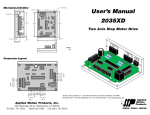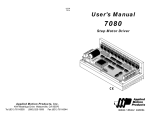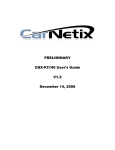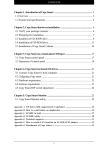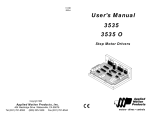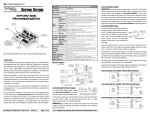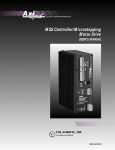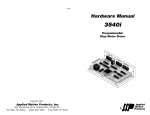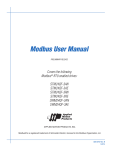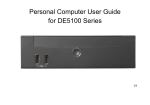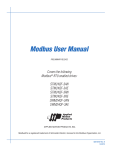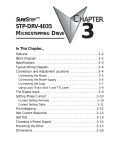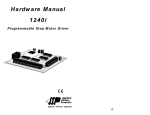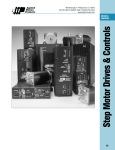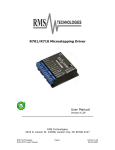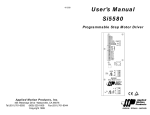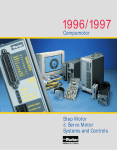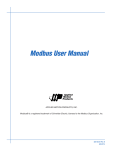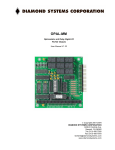Download 3540M Step Motor Driver
Transcript
7/14/98 User's Manual 3540 M Step Motor Driver Applied Motion Products, Inc. 404 Westridge Drive • Watsonville, CA 95076 Tel (831) 761-6555 (800) 525-1609 Fax (831) 761-6544 motors • drives • controls Technical Specifications Introduction Thank you for selecting an Applied Motion Products motor control. We hope our dedication to performance, quality and economy will make your motion control project successful. If there's anything we can do to improve our products or help you use them better, please call or fax. We'd like to hear from you. Our phone number is (800) 5251609 or you can reach us by fax at (831) 761-6544. Amplifiers Dual, bipolar MOSFET H-bridge, pulse width modulated three state switching at 20kHz. 12-42 VDC input. 0.4 - 3.5 amps/phase output current, switch selectable in 0.1 A increments. 122 watts maximum output power. Automatic idle current reduction (switch selectable), reduces current to 50% of setting after one second. Inputs Step, direction and enable, optically isolated, 5V logic. 5mA/signal, sink requirement. Motor steps on rising edge of step input. 0.5 µsec minimum pulse width. 2 µsec minimum set up time for direction signal. Physical Mounted on 1/4 inch thick black anodized aluminum heat transfer chassis. 1.5 x 3.0 x 4.0 inches overall. Power on red LED. See drawing on page 14 for more information. Maximum chassis temperature: 70° C. Connectors European style screw terminal blocks. Max wire size: AWG 18. Motor: 4 position (A+, A-, B+, B-) Signal Input: 4 position (+5, STEP, DIR, EN) DC Input: 2 position (V+, V-) Self Test Switch selectable, rotates motor 1/2 revolution each direction at 100 steps/second, half step mode. Features • • • • • • Drives sizes 14 through 34 step motors Pulse width modulation, MOSFET 3 state switching amplifiers Phase current from 0.4 to 3.5 amps (switch selectable, 32 settings) Optically isolated step, direction and enable inputs Half, 1/5, 1/10, 1/64 step (switch selectable) Automatic 50% idle current reduction (can be switched off) Block Diagram 12-42 VDC self test on/off current 0.4 to 3.5 A/phase 5V Reg step Optical Isolator Microstep Sequencer +5 direction enable Optical Isolator MOSFET Amplifier step resolution 1/2, 1/5, 1/10 or 1/64 Optical Isolator A+ AB+ B- to motor 50% idle current reduction on/off Microstepping Four switch selectable step resolutions. With 1.8¡ motor: Half step (400 steps/rev) 1/5 step (1000 s/r) 1/10 step (2000 s/r) 1/64 step (12,800 s/r) Other resolutions, up to 12,800, available to qualified OEMs upon request. CE Mark -2- Complies with EN55011A and EN50082-1(1992). -15- Mechanical Outline Getting Started To use your Applied Motion Products motor control, you will need the following: 4x Ø.125 1.50" 0.125" 2.50" 2x Ø.125 3.70" 3.75" 4.00" • a 12-42 volt DC power supply for the motor. Please read the section entitled Choosing a Power Supply for help in choosing the right power supply. • +5 volts DC, 15mA to activate the optoisolation circuits (if you don't use 5 volt logic, see page 6.) This is provided by most indexers and PLCs. • a source of step pulses capable of sinking at least 5 mA • if your application calls for bidirectional rotation, you'll also need a direction signal, capable of sinking 5 mA • a compatible step motor • a small flat blade screwdriver for tightening the connectors The sketch below shows where to find the important connection and adjustment points. Please examine it now. 0.25" 0.15" 3.00" 0.25" power connector .875" motor connector mounting hole (1 of 6) switches for selecting current, step resolution, self test -14- logic connector (STEP, +5, DIR, EN) -3- Connecting the Power Supply If you need information about choosing a power supply, please read Choosing a Power Supply located on page 12 of this manual. The PS430 from Applied Motion Products is a good supply for this drive. Mounting the Drive You can mount your drive on the wide or the narrow side of the chassis. If you mount the drive on the wide side, use #4 screws through the four corner holes. For narrow side mounting applications, you can use #4 screws in the two side holes. If your power supply does not have a fuse on the output or some kind of short circuit current limiting feature you need to put a 4 amp fast acting fuse between the drive and power supply. Install the fuse on the + power supply lead. smooth flat surface Connect the motor power supply + terminal to the driver terminal labeled "+ VDC". Connect power supply Ð to the drive terminal labeled "VDC Ð". Use no smaller than 20 gauge wire. Be careful not to reverse the wires. Reverse connection will destroy your driver, void your warranty and generally wreck your day. fuse + VDC – motor + supply 12-42 VDC – wide side mount Connecting the Motor Warning: When connecting the motor to the driver, be sure that the motor power supply is off. Secure any unused motor leads so that they can't short out to anything. Never disconnect the motor while the drive is powered up. Never connect motor leads to ground or to a power supply! You must now decide how to connect your motor to the drive. A+ Four lead motors can only be connected one way. Please follow the sketch at the right. A– Red #4 screws narrow side mount The amplifiers in the drive generate heat. Unless you are running at 1 amp or below, you may need a heat sink. To operate the drive continuously at maximum power you must properly mount it on a heat sinking surface with a thermal constant of no more than 4°C/watt. Applied Motion Products can provide a compatible heat sink. Often, the metal enclosure of your system will make an effective heat sink. Never use your drive in a space where there is no air flow or where other devices cause the surrounding air to be more than 70 °C. Never put the drive where it can get wet or where metal particles can get on it. 4 lead motor Blue White Yellow Six lead motors can be connected in B+ B– series or center tap. In series mode, motors produce more torque at low speeds, but 4 Leads cannot run as fast as in the center tap configuration. In series operation, the motor should be operated at 30% less than rated current to prevent overheating. Wiring diagrams for both connection methods are shown on the next page. NC means not connected to anything. -4- -13- Choosing a Power Supply Voltage Chopper drives work by switching the voltage to the motor terminals on and off while monitoring current to achieve a precise level of phase current. To do this efficiently and silently, you'll want to have a power supply with a voltage rating at least five times that of the motor. Depending on how fast you want to run the motor, you may need even more voltage. More is better, the only upper limit being the maximum voltage rating of the drive itself: 42 volts (including ripple). If you choose an unregulated power supply, do not exceed 30 volts DC. This is because unregulated supplies are rated at full load current. At lesser loads, like when the motor is not moving, the actual voltage can be up to 1.4 times the voltage list on the power supply label. Current The maximum supply current you will need is the sum of the two phase currents. However, you will generally need a lot less than that, depending on the motor type, voltage, speed and load conditions. That's because the 3540 M uses switching amplifiers, converting a high voltage and low current into lower voltage and higher current. The more the power supply voltage exceeds the motor voltage, the less current you'll need from the power supply. We recommend the following selection procedure: 1. If you plan to use only a few drives, get a power supply with at least twice the rated phase current of the motor. 2. If you are designing for mass production and must minimize cost, get one power supply with more than twice the rated current of the motor. Install the motor in the application and monitor the current coming out of the power supply and into the drive at various motor loads. This will tell you how much current you really need so you can design in a lower cost power supply. If you plan to use a regulated power supply you may encounter a problem with current foldback. When you first power up your drive, the full current of both motor phases will be drawn for a few milliseconds while the stator field is being established. After that the amplifiers start chopping and much less current is drawn from the power supply. If your power supply thinks this initial surge is a short circuit it may "foldback" to a lower voltage. With many foldback schemes the voltage returns to normal only after the first motor step and is fine thereafter. In that sense, unregulated power supplies are better. They are also less expensive. The PS430 from Applied Motion Products is a good supply to use with the 3540 M. -12- Grn/Wht A– NC A+ A– 6 lead motor White Green A+ NC Red/ Wht Red B– Black NC Grn/Wht 6 lead motor White Green Red/ Wht Red B– B+ 6 Leads Series Connected Black B+ NC 6 Leads Center Tap Connected Eight lead motors can also be connected in two ways: series or parallel. As with six lead motors, series operation gives you more torque at low speeds and less torque at high speeds. In series operation, the motor should be operated at 30% less than the rated current to prevent over heating. The wiring diagrams for eight lead motors are shown below. A+ Orange Blk/Wht Org/ Wht A– Black Red B+ Red/ Wht Orange Blk/Wht 8 lead motor Org/Wht A– A+ Yellow Yel/ Wht B– 8 lead motor Black Red Yel/ B+ Wht Yel low Red/Wht B– 8 Leads Parallel Connected 8 Leads Series Connected Connecting Logic The 3540 M contains optical isolation circuitry to prevent the electrical noise inherent in switching amplifiers from interfering with your circuits. Optical isolation is accomplished by powering the motor driver from a different supply than your circuits. There is no electrical connection between the two: signal communication is achieved by infrared light. When your circuit is in the logic low state (near 0 volts), it is directing electrical current through an LED that is built into the drive. The LED, in turn, produces infrared light which turns on a phototransistor that is wired to the brains of the drive. When your circuit is in the logic high state, the LED and phototransistor turn off. -5- Your drive is equipped with a feature that automatically reduces the motor current by 50% anytime the motor is not moving. This reduces drive heating by about 50% and lowers motor heating by 75%. This feature can be disabled if desired so that full current is maintained at all times. This is useful when a high holding torque is required. To minimize motor and drive heating we highly recommend that you enable the idle current reduction feature unless your application strictly forbids it. 680 You must supply 5 volts DC to supply current to the LEDs on the input side of the optoisolators. The maximum current draw is 15 mA total. Your controlling logic must be capable of +5V sinking at least 5 mA to control each drive input. Most CMOS and open collector TTL devices are directly compatible with this drive. STEP Logic low, or 0, for a given input occurs when that input is pulled to less than 0.8 volts DC. DIR In this state the LED is conducting current. Logic high, or 1, occurs when the input is EN Drive Input Circuit greater than 4 volts or open. 680 Idle Current Reduction 680 A schematic diagram of the input circuit is shown below. Idle current reduction is enabled by sliding switch #4 toward the 50% IDLE label,as shown in the sketch below. Sliding the switch away from the 50% IDLE label disables the reduction feature. DIRECTION signals which way the motor should turn. See the step table on page 8 for details. The DIRECTION signal should be changed at least 2 microseconds before a step pulse is sent. If you change the state of the direction input and send a step pulse at the same instant the motor may take a step in the wrong direction. ENABLE allows the user to turn off the current to the motor by setting this signal to logic 0. The logic circuitry continues to operate, so the drive "remembers" the step position even when the amplifiers are disabled. However, the motor may move slightly when the current is removed depending on the exact motor and load characteristics. If you have no need to disable the amplifiers, you don't need to connect anything to the ENABLE input. Using Logic Voltages other than 5 volts DC Self Test The 3540 M includes a self test feature. This is used for trouble shooting. If you are unsure about the motor or signal connections to the drive, or if the 3540 M isn't responding to your step pulses, you can turn on the self test. To activate the self test, slide switch #1 toward the TEST label. The drive will slowly rotate the motor, 1/2 revolution forward, then 1/2 rev backward. The pattern repeats until you slide the switch away from the TEST label. The 3540 M always uses half step mode during the self test, no matter how you set switches 2 and 3. The self test ignores the STEP and DIRECTION inputs while operating. The ENABLE input continues to function normally. TEST TEST Self Test ON 1 -6- No Current Reduction 1 The 3540 M was designed to be used with 5 volt CMOS and TTL logic signals. To prevent interference between the drive and the controlling logic, the input signals are optically isolated. That means that your signals are powering LEDs within the drive's optocoupler circuits. The LEDs require at least 5 milliamps of current to turn on, but cannot stand more than 20 mA. Since the LEDs themselves only drop about two volts, current limiting resistors must be used on each logic input. Idle Current Reduction Selected 4 STEP tells the driver when to move the motor one step. The drive steps on the falling edge of the pulse. The minimum pulse width is 0.5 microseconds. 50% IDLE 4 50% IDLE Self Test OFF -11- Microstepping Most step motor drives offer a choice between full step and half step resolutions. In most full step drives, both motor phases are used all the time. Half stepping divides each step into two smaller steps by alternating between both phases on and one phase on. Microstepping drives like the 3540 M precisely control the amount of current in each phase at each step position as a means of electronically subdividing the steps even further. The 3540 M offers a choice of half step and 3 microstep resolutions. The highest setting divides each full step into 64 microsteps, providing 12,800 steps per revolution when using a 1.8˚ motor. In addition to providing precise positioning and smooth motion, microstep drives can be used to provide motion in convenient units. When the drive is set to 2000 steps/rev (1/10 step) and used with a 5 pitch lead screw, you get .0001 inches/step. Please refer to the table below and set the switches for the resolution you want. If your logic voltage is higher than five volts, you must add a resistor in series with each signal that you use (STEP, DIR and EN). The recommended wiring diagram is shown below. Table I lists the appropriate resistor value to use for a given power supply voltage. 1/4 watt or larger resistors should be used. Please take care not to reverse the wiring, as damage to the LEDs will result rendering the drives inoperable. Check your wiring carefully before turning on the power supply! +V (12-42 volts DC) R INPUT SIGNALS STEP DIR R EN R STEP +5 DIR EN Setting the step resolution is easy. Look at the dip switch on the 3540 M. Next to switches 2 and 3, there are labels on the printed circuit board. Each switch has two markings on each end. Switch 2 is marked 1/5, 1/10 at one end and 1/5, 1/64 at the other. Switch 3 is labeled 1/2, 1/5 and 1/10, 1/64. To set the drive for a resolution, push both switches toward the proper label. For example, if you want 1/10 step, push switch 2 toward the 1/10 label (to the left) and push switch 3 toward 1/10 (on the right). We have included the proper resistor (680 ohms) within the drive for 5 volt operation. Therefore, if your logic voltage is 5 volts, you do not need to add resistors externally. 3540 M drive Note: DIR signal is only required for bidirectional motion. EN signal is only required to shut off motor current. Both inputs can be left open if not needed. Table I: External Dropping Resistors 1/5 1/64 1/10 1/64 STEPS/REV (1/10) 12800 STEPS/REV (1/64) -10- 1/2 1/10 1/5 1/2 1/2 1/10 1/5 1/2 1/5 1/64 1/10 1/64 2 3 1/2 1/10 1/5 1/2 2000 2 3 1000 STEPS/REV (1/5) 1/5 1/64 1/10 1/64 2 3 STEPS/REV (HALF) 1/2 1/10 1/5 1/2 2 3 400 1/5 1/64 1/10 1/64 Supply Voltage 12 15 18 R Ohms 1200 1800 2400 Supply Voltage 21 24 27 -7- R Ohms 3000 3600 4200 Supply Voltage 30 33 35 R Ohms 4700 5100 5600 Current Setting Table Step Table (half stepping) 0.1 0.2 0.4 0.8 1.6 0.1 0.2 0.4 0.8 1.6 0.1 0.2 0.4 0.8 1.6 0.1 0.2 0.4 0.8 1.6 5 6 7 8 9 0.1 0.2 0.4 0.8 1.6 5 6 7 8 9 AMPS/ PHASE 0.1 0.2 0.4 0.8 1.6 5 6 7 8 9 5 6 7 8 9 3.0 5 6 7 8 9 0.1 0.2 0.4 0.8 1.6 AMPS/ PHASE 0.1 0.2 0.4 0.8 1.6 5 6 7 8 9 0.1 0.2 0.4 0.8 1.6 2.9 5 6 7 8 9 0.1 0.2 0.4 0.8 1.6 AMPS/ PHASE 0.1 0.2 0.4 0.8 1.6 5 6 7 8 9 0.1 0.2 0.4 0.8 1.6 2.8 5 6 7 8 9 0.1 0.2 0.4 0.8 1.6 5 6 7 8 9 AMPS/ PHASE 0.1 0.2 0.4 0.8 1.6 5 6 7 8 9 2.2 5 6 7 8 9 AMPS/ PHASE 0.1 0.2 0.4 0.8 1.6 5 6 7 8 9 0.1 0.2 0.4 0.8 1.6 2.1 5 6 7 8 9 0.1 0.2 0.4 0.8 1.6 AMPS/ PHASE 0.1 0.2 0.4 0.8 1.6 5 6 7 8 9 0.1 0.2 0.4 0.8 1.6 2.0 5 6 7 8 9 0.1 0.2 0.4 0.8 1.6 0.1 0.2 0.4 0.8 1.6 5 6 7 8 9 0.1 0.2 0.4 0.8 1.6 0.1 0.2 0.4 0.8 1.6 5 6 7 8 9 0.1 0.2 0.4 0.8 1.6 AMPS/ PHASE 0.1 0.2 0.4 0.8 1.6 5 6 7 8 9 0.1 0.2 0.4 0.8 1.6 1.4 5 6 7 8 9 0.1 0.2 0.4 0.8 1.6 AMPS/ PHASE 0.1 0.2 0.4 0.8 1.6 5 6 7 8 9 AMPS/ PHASE 0.1 0.2 0.4 0.8 1.6 1.3 5 6 7 8 9 0.6 AMPS/ PHASE 0.1 0.2 0.4 0.8 1.6 5 6 7 8 9 AMPS/ PHASE 0.1 0.2 0.4 0.8 1.6 1.2 5 6 7 8 9 0.5 5 6 7 8 9 DIR=0 ccw 5 6 7 8 9 AMPS/ PHASE 0.1 0.2 0.4 0.8 1.6 5 6 7 8 9 0.4 5 6 7 8 9 B– – open + + + open – – 5 6 7 8 9 B+ + + open – – – open + + 5 6 7 8 9 Aopen – – – open + + + open 5 6 7 8 9 A+ open + + + open – – – open 5 6 7 8 9 DIR=1 cw Step 0 1 2 3 4 5 6 7 8 Step 0 is the Power Up State Setting Phase Current 0.7 Before you turn on the power supply the first time, you need to set the driver for the proper motor phase current. The rated current is usually printed on the motor label. The 3540 M drive current is easy to set. If you wish, you can learn a simple formula for setting current and never need the manual again. Or you can skip to the table on the next page, find the current setting you want, and set the DIP switches according to the picture. AMPS/ PHASE Current Setting Formula Locate the bank of tiny switches near the motor connector. Four of the switches have a value of current printed next to them, such as 0.4 and 0.8. Each switch controls the amount of current, in amperes (A), that its label indicates. There is always a base of current of 0.4 A. To add to that, slide the appropriate switches toward their labels on the PC board. You may need your small screwdriver for this. -8- AMPS/ PHASE 0.9 AMPS/ PHASE 1.0 AMPS/ PHASE 0.1 0.2 0.4 0.8 1.6 5 6 7 8 9 Example Suppose you want to set the driver for 2.2 amps per phase. You need the 0.4 A base current plus another 1.6 and 0.2 A. 2.2 = 0.4 + 1.6 + 0.2 Slide the 1.6 and 0.2 A switches toward the labels as shown in the figure. 0.8 1.1 AMPS/ PHASE 1.5 AMPS/ PHASE 1.6 AMPS/ PHASE 1.7 AMPS/ PHASE 1.8 AMPS/ PHASE 1.9 AMPS/ PHASE -9- 2.3 AMPS/ PHASE 2.4 AMPS/ PHASE 2.5 AMPS/ PHASE 2.6 AMPS/ PHASE 2.7 AMPS/ PHASE 3.1 AMPS/ PHASE 3.2 AMPS/ PHASE 3.3 AMPS/ PHASE 3.4 AMPS/ PHASE 3.5 AMPS/ PHASE








